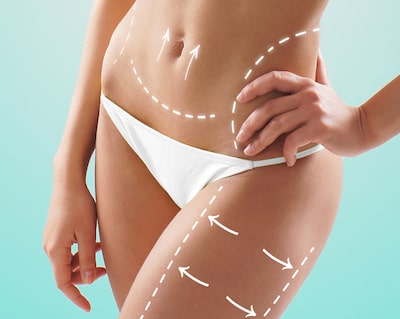No matter how much a person tries to lose weight, there are some areas of stubborn fat that seem resistant to regular diet and exercise. Patients that have trouble losing their desired amount of fat often turn to liposuction to eliminate unwanted fat from the body. One of the most common questions asked by the public is “How much fat can safely be removed from the body during a liposuction procedure?” Let’s take a look at the answer to this common question.
 The most important thing to remember before having a liposuction procedure is the fact that liposuction is performed to contour the body. It is not a weight loss procedure and should not be performed on patients that want to have liposuction for that reason. When planning to have a liposuction procedure, patients should focus on the changes they want to make in the shape or contour of the targeted area of the body.
The most important thing to remember before having a liposuction procedure is the fact that liposuction is performed to contour the body. It is not a weight loss procedure and should not be performed on patients that want to have liposuction for that reason. When planning to have a liposuction procedure, patients should focus on the changes they want to make in the shape or contour of the targeted area of the body.
Having said that, there is an easy method a patient can perform to determine the amount of fat that can be removed from an area filled with stubborn fat. The patient can take their thumb and index finger and pinch the tissue in the area where the liposuction will be performed. The thickness of the tissue in the targeted area is considered to be a good representation of the volume of fat located in the area. The pinch will also give a good indication of how much fat can be removed in order to provide a better shape or contour to the targeted section of the body.
In general, it is best to not remove more than 5000-6000 ml of fat and fluid during a single liposuction procedure (this equates to about 11-12 pounds). This does not mean that the patient will lose that amount of weight during the procedure. It simply means the total amount of fat, body fluids and blood that is removed will not equal more than 11-12 pounds. In fact, the amount of actual fat removed during the procedure might only equal two or three pounds.
This might be surprising to some people, but it is important to remember that the purpose of liposuction is not to lose weight. The purpose is to give the body a better contour and shape in the targeted area. A skilled surgeon can provide an enhanced look to the figure of a person as well as an improved silhouette and contour. While the amount of fat removed might not be a large number, the changes made to the contour of the body can actually make a dramatic difference in the appearance of the body. If the desired changes can be achieved by only removing 2-3 pounds of fat or fluid, there is not much of a reason to remove 11-12 pounds of fat and fluid from the body.
It is also important to remember that there are some risks associated with the removal of too much fat during liposuction. One of the first risks is a final appearance that is not natural in appearance as well as being unattractive in its look. There is a chance of the skin showing some hollow dimpling or lumps that will be visible to others.
There are also possible health risks that patients should be aware of before undergoing liposuction. Some of these risks include:
In addition, a larger removal of fat will make the procedure take a longer amount of time to perform. If the surgery is longer and more involved, the recovery time can also take longer than a liposuction surgery that involves the removal of less fat and fluid.
While the above information is a good starting point for anyone interested in having the procedure, it is important to schedule a consultation appointment with a board-certified doctor who is experienced in performing liposuction. The doctor will examine the patient to determine if the person is an ideal patient for the procedure. The examination includes making sure the patient is healthy enough to undergo the procedure.
The surgeon will also discuss the reasons why the person wants to have the surgery as well as learn more about the desired final results. It is important to set realistic expectations so the patient will know what can be accomplished when it comes to the changes in the contour and shape of the body. Realistic expectations will help to prevent the person from being unhappy or disappointed with the end result of the surgery.
The doctor will also make sure the patient wants to have the surgery to achieve the results they desire as opposed to undergoing a liposuction procedure to make someone else happy with the appearance of their body.